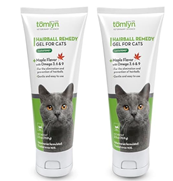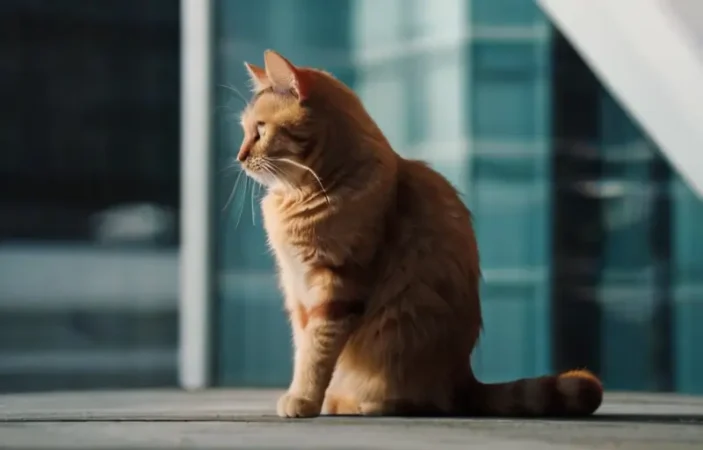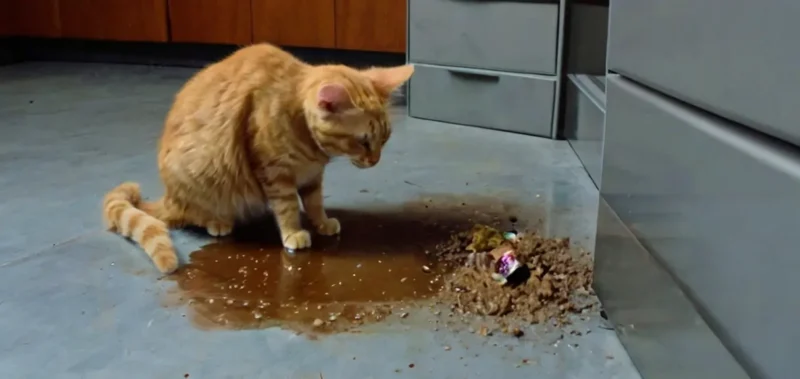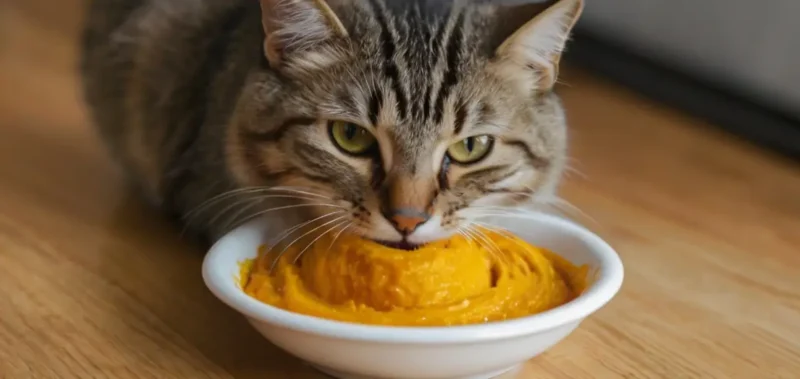Using Laxatone for cats constipation issues is a viable option. If your cat is displaying unusual behavior or appears uncomfortable, particularly due to constipation, it’s natural to feel concerned. Cats dedicate approximately five hours daily to grooming themselves, a habit that can sometimes lead to constipation or discomfort. Laxatone serves as a solution to alleviate this problem. Many cat owners rely on Laxatone as a remedy to help their cats find relief from constipation. Now, let’s delve into what exactly Laxatone is and how quickly it can provide relief.
What is Laxatone?
Laxatone is a supplement composed mainly of corn oil, white petroleum, molasses, light mineral oil, gelatin, and soybean oil. As the name implies, it is mainly used as a lubricant to help the cat pass hairs through its digestive system without any pain or inconvenience.
We use laxatone for cats constipation in the form of an oral gel that is used to lubricate the cat’s digestive system. Simply, it is a white petroleum which is almost the same as petroleum jelly. In routine, many of us use these petroleum jellies to moisturize our skins or for lubrication purposes. Vaseline is a widely used petroleum jelly brand all over the world.
| Medical type | Form | Prescription | Common name | Precautions | Life stage |
|---|---|---|---|---|---|
| Lubricant | Oral Gel | Better to consult a vet before using | Petroleum | Keep at cool and dry place | All life stages |
To Purchase laxatone at the cheapest rates you can click on the link below or the image below:
How Does Laxatone Work for Cats’ Constipation?
Understanding the mechanism of Laxatone in addressing feline constipation is straightforward. Laxatone adds important fatty acids to make the ingested hairs pass easily through the stool. The active ingredients lubricate the cat’s digestive system, which makes the swollen hairs easily pass through the intestines and get exposed along with stool. It prevents the formation of hairballs in the cat’s intestine, which usually get stuck and become a cause of pain and constipation for cats. The Laxatone for cats is available in tuna as well as malt flavors, making it easier for cats to consume. Most cats like the tuna flavor.
How Long Does It Take for Laxatone to Resolve Constipation?
It is a frequently asked question as most people feel it’s ineffective for their pet and get unsatisfied within 7-8 hours after its usage. They assume using laxatone for cats constipation is not a good idea. Actually, there is not a fixed tenure it takes to work, but it depends on several factors which include your cat’s health, age, and the severity level of constipation.
In most cases, results are observed within 2 days or 48 hours. But for some cats, it takes almost 5-6 days. Continuously check the litter box after regular time intervals. Still, if you cannot feel any effect, you might consult the veterinarian.
In some cases, you might notice some adverse effects too. Immediately consult the veterinarian for better treatment of your pet. Giving your cat an enema would be a better option instead of continuous use of Laxatone. It is a better remedy with immediate results.
Is My Cat Experiencing Constipation?
Are you worried about the weird behavior of your cat? It might not be a big issue. This awkward behavior can be because of constipation. There are many signs to judge if your cat is suffering from constipation or not.
Symptoms of Cat Constipation
Here are a few cats constipation symptoms:
- Frequent visits to the litter box
- Abdominal pain
- No fecal production while trying to poop again and again
- Vomiting
- Hard and dry stool
- Discomfort
- Decreased appetite
Mostly cats exhibit some of the above-mentioned symptoms when suffering through constipation.
NOTE: Only use Laxatone if you observe any of these symptoms in your cat.
How Much Laxatone Should I Give to My Cat?
Place a small amount of Laxatone of different flavors on your cat’s nose, approximately between ½-1 teaspoon on a daily basis for two to three days. Give different flavors and analyze the one it likes more. Most veterinarians suggest it to be followed by ¼-1/2 teaspoon not more than twice or thrice a week.
For hairballs, you should give Laxatone to your cat daily, typically followed by a reduction in both frequency and quantity. Even if you increase the frequency of Laxatone administration for a cat experiencing constipation, you may not notice consistent improvement.
Does Laxatone Make Cats Throw Up?
Since the working of Laxatone has been explained, it is not necessary for the cat to expel the hairball through feces, but it can also expel it by vomiting. Thus using laxatone for cats constipation can be a cause for cats throwing up. But if you notice an increased ratio of vomiting with no hairball, must consult a vet. This is because excess use of Laxatone has allergic side effects. Excess vomiting is one of those of side effects.
Some of the common symptoms unlikely related to Laxatone administration are:
- Trouble pooping
- Vomiting
- Poor appetite
- Small amounts of liquid stool
What Are the Side Effects of Laxatone on Cats?
There are a number of side effects of constant use of Laxatone for cats constipation, but it depends on the quantity used. Using a very small quantity has very minimal side-effects or approximately no side effects, but its excessive use offer a number of side effects. In some cases, using a good amount of Laxatone on a daily basis weakens your cat and triggers following health issues:
- Cat becomes lethargic
- Signs of weakness and laziness
- Discomfort
- Excess vomiting
- Diarrhea
If you notice any irregular behavior of your cat other than those mentioned above, stop the use of Laxatone.
What Are Other Uses of Laxatone?
Primarily laxatone for cats is used to help facilitate the digestive system of pets. It is not only used for cats but it can also be used for dogs. Both cats and dogs suffer constipation due to the formation of hairballs. The omega -3, omega -6, and omega -9, these fatty acids found in Laxatone, help to stimulate the process of passing stool for animals. Some other uses of Laxatone are:
- Some Veterinarians recommend Laxatone as part of post-surgery care for cats to prevent constipation and promote smooth recovery.
- During dietary changes or transitions, Laxatone can help prevent digestive upset and constipation by promoting regular bowel movements and easing the adjustment period for the cat’s digestive system.
You can find it on Amazon, online pharmacies, or any physical pharmacy.
Can We Mix Laxatone With Cat Food?
Yes, it is possible to mix Laxatone with your cat’s food, but it is not recommended due to following reasons:
- Mixing Laxatone with cat food may reduce its effectiveness.
- Cats may detect the texture or taste of Laxatone when mixed with their food, leading them to avoid eating the food altogether.
- When Laxatone is mixed with cat food, it becomes challenging to monitor the exact dosage the cat receives.
- Mixing Laxatone with cat food increases the risk of food spoilage.
Try feeding Laxatone to your cat with your hands instead of mixing it with its meals. Another good method is to place it over its nose or on the side of its mouth. Most probably your cat will lick it. You can put some Laxatone on top of its paw too.
Other Alternatives to Laxatone
Although using laxatone for cats to resolve constipation is a good option, still there are some natural cats constipation remedy. There are a number of alternatives to Laxatone you could adopt if your cat is allergic to Laxatone. Some of the alternatives best among them are discussed here.
- MIRALAX
- PUMPKIN
- PSYLLIUM HUSK
MIRALAX (Cats Constipation Remedy)
Miralax is a mild laxative made for humans, but ingredients used in it are safe enough to use it for cats. Using Miralax for cats constipation is a good option. It serves the same purpose as using laxatone for cats constipation would. Many vets recommend it. The working procedure of Miralax involves binding the moisture in your cat’s intestine, making it easier for it to expel stool or hairballs. It comes in a powder form and has no taste, making it easier to mix with your cat’s food.
Here is a link of a forum to know more about the difference between Miralax and Laxatone. https://thecatsite.com/threads/miralax-vs-lactulose-your-experiences.216296/page-2
PUMPKIN (Cats Constipation Remedy)
If you are not interested in using Laxatone or other medical inventions, pumpkin is an organic alternative to a laxative. Pumpkin can be used for cat constipation instead of using laxatone for cats constipation. it’s a natural remedy. All you have to do is to boil or blend the pumpkin and give ¼-1/2 teaspoon to your cat daily. Soon you will observe differences. Actually, pumpkin helps the digestive system and makes a smoother flow of feces in the intestinal system, making it easier to expel the hairball.
To know more about health benefits of pumpkin, you can visit the link: https://www.inspirahealthnetwork.org/news/5-health-benefits-pumpkin-spookiest-superfood
PSYLLIUM HUSK (Cats Constipation Remedy)
Psyllium husk is again a good alternative if your cat doesn’t like the pumpkin’s taste. It is tasteless and can be easily mixed with your cat’s food, but it cannot be used if you are feeding your cat a dry diet.
Using Laxatone for cats constipation typically takes around 24-48 hours to resolve cat constipation. However, it is important to consult with a veterinarian for proper dosage and usage instructions. Additionally, natural remedies like psyllium husk can also be effective in relieving cat constipation. Psyllium husk can be mixed with your cat’s food and should be given in a dosage of ¼-1/2 teaspoon daily.
Moisture as the water causes the husk to coat your cat’s intestinal wall with a gel-like substance which makes it easier to expel the hairball. You can feed your cat ¼-1/2 teaspoon of psyllium husk on a daily basis.
To know more about PSYLLIUM HUSK, you can visit the link.
Does Olive Oil Help Cats Poop?
Many of use olive oil for cooking our meals just because of it’s benefits for humans. Olive oil is primarily composed of monounsaturated fatty acids. The high content of monounsaturated fats reduces the risk of heart disease, stroke, and certain types of cancer in humans. But the benefits of olive oil in cats are restricted to a certain extent. Cat’s bodies are designed in a different way than humans. This is why many things we found helpful for humans don’t prove themselves good for pets.
Due to it’s chemical composition, olive is a lubricant that serves as a laxative for cat’s digestive track. Thus it softens stool in cat’s intestines and aids it’s movement. Here are a few tips you must consider if using olive oil for resolving your cat’s constipation:
- Don’t give more than 1/2 teaspoon of olive oil to your cat per day. Feeding larger quantities may show inverse results. There are possibilities of diarrhea.
- Don’t try using such remedies without consulting your vet. Not in all cases such measures prove helpful.
- First try to resolve cat’s constipation by including high fiber products in it’s diet.
I would personally recommend to try feeding your cat with pumpkin puree or psyllium husk rather than using olive oil.
When Should I Bring My Cat to See a Vet?
In case the condition is not too severe, you can opt for any of the above remedies for the very first two days or 48 hours. Most of the time, much improvement is observed within this time frame. If you cannot see any improvement within 72 hours, it’s time to seek an appointment with the vet. The vet would take all the precautionary measures required for treatment.
Conclusion
Since it is mentioned above that cats spend 5 hours a day on their grooming, constipation in cats is much more common than you could imagine, but its cure is not too difficult. You can easily treat your cat using the above remedies, but consulting a vet is always a better option.







5 thoughts on “How to Use Laxatone For Cats Constipation?2024 Research”